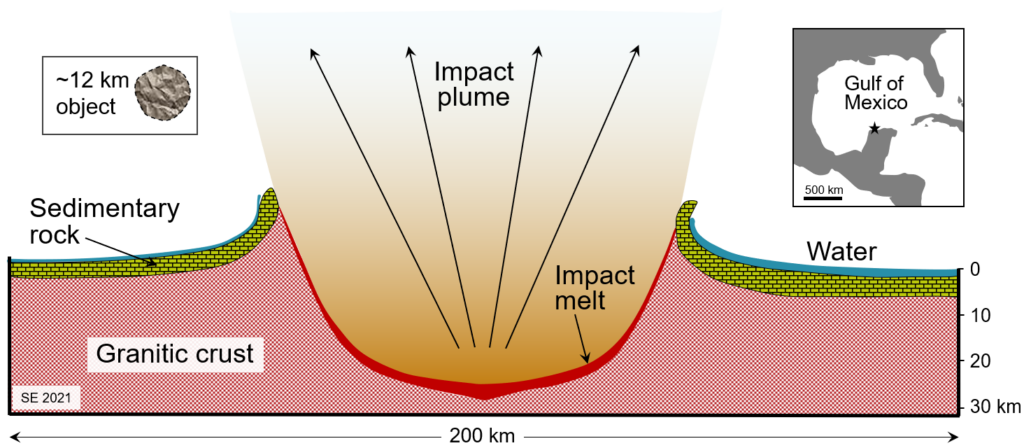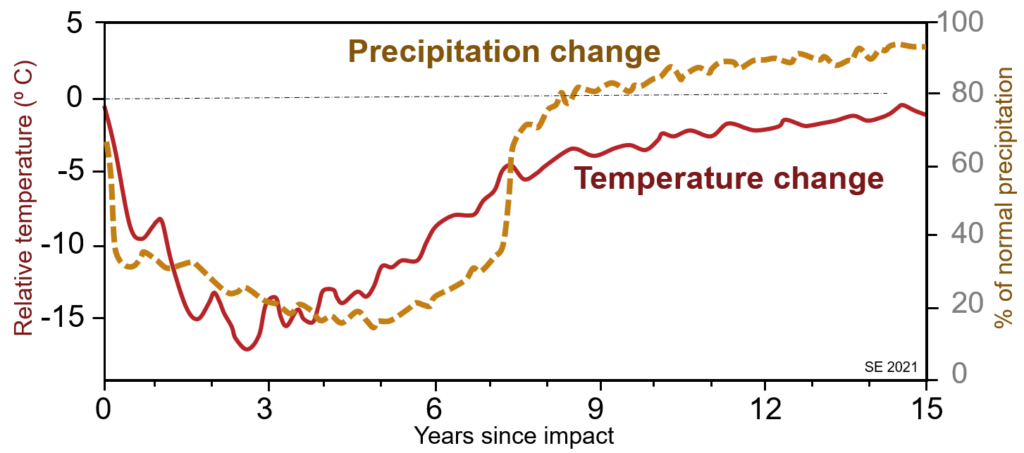3.6 Extraterrestrial Impacts and Climate Change
There is strong consensus in the geological community that the significant extinction at the end of the Cretaceous (the K-Pg extinction for Cretaceous-Paleogene) was primarily caused by the impact of a large meteorite. Recent evidence from drilling into the site of the impact, off the coast of the village of Chicxulub in Mexico’s Yucatan region, has provided some new insights into what happened in the seconds to millennia following that event.
It is estimated that the Chicxulub object was approximately 12 km in diameter and that it hit the Earth at about 100,000 km/h.[1] It landed in an area of relatively shallow sea water (a few hundred metres depth) that was underlain by about 5 km thickness of limestone and evaporite rocks. Limestone is primarily calcium carbonate (CaCO3), and a major component of the evaporite layer is calcium sulphate (CaSO4). The impactor exploded through those sedimentary layers in a fraction of a second, and then excavated a hole nearly 100 km wide and 20 km deep into the granitic rocks of the crust (Figure 3.6.1). All of that material was immediately melted or vaporized, and the solid particles were blasted out of the atmosphere.

The sudden change in the level of the sea floor within and around the crater created an enormous tsunami that spread across the Gulf of Mexico and out into the Atlantic and to the Pacific (as this predates the Isthmus of Panama). Within the gulf, the wave would have been as much as 1500 m high, and it was likely more than 15 m high in both the Pacific and Atlantic basins.[2] This wreaked massive destruction in the extensive low-lying areas around the gulf, and then the water rebounded back towards Chicxulub, refilling much of the crater with sediments from around the region and with debris from the blast. The back-filled material included a large volume of charcoal, presumably from wildfires in areas around the gulf.
The rock fragments and glass of the impact plume were sent aloft through the atmosphere and dispersed across an area with a radius of at least 6000 km. On re-entry, friction turned this material into glowing bodies with enough intensity to outshine the sun by a factor of seven times, and enough heat to start wildfires within a radius of at least 6000 km from the impact site (i.e., all of North and South America), and possibly almost everywhere on Earth. Animals that could not hide underground or in water, would likely have perished in the resulting fires, if they hadn’t already been killed by the incandescent heat.
Wildfires of the magnitude described above would have created a massive amount of smoke, and the layer of soot from that smoke has been found in K-Pg boundary-layer deposits around the world. It amounts to approximately 15 giga tonnes (Gt), which is many hundreds of times the amount of soot produced by wildfires in a typical year, and is enough to have effectively blocked most of the incoming sunlight. A digital model of the early-Paleogene climate following the emission of 15 Gt of wildfire soot shows that for several years the average insolation at the Earth’s surface was likely less than 1% of normal, and for low-latitude regions it was probably only a fraction of that. [3] In other words, it was permanently dark—although not quite as dark as night-time—for years. Under those conditions, photosynthesis, and therefore growth of plants, on both land and in the oceans, was effectively stopped. Mean annual temperature in most continental areas, including equatorial regions, dropped to less than 0⁰ C, or 10 to 15⁰ C below normal (Figure 3.6.2), in some temperate and polar areas it was much less, although it probably stayed above freezing over tropical and temperate oceans. Precipitation dropped to about 20% of normal levels, typical of deserts in most regions. It is likely that the darkness started to lift after about two years, but the cold and dry conditions persisted for six to eight years.

Needless to say, survival would have been difficult under such conditions, even for the fittest. Animals that had survived the heat blast and the raging wildfires, would have emerged from burrows, crevices and swamps to find permanent near darkness, no new plant growth, wicked cold and, soon, almost no fresh water.
And that’s not all, because the modelling described above didn’t account for the 650 Gt of sulphur dioxide that would have been formed by the instantaneous vaporization of the thick beds of calcium sulphate—roughly 100 times the amount produced by the climate-cooling eruption of Pinatubo in 1991. This SO2 would have quickly been converted to H2SO4 droplets (sulphuric acid) in the atmosphere, which as long as they stayed up there (likely a few years), would have made the cooling even stronger. When significant rain finally returned, likely sometime in the sixth or seventh years, it would have been acidic.
In addition to soot, the wildfires would have produced a massive amount of CO2, and CO2 was also emitted by the vaporization of limestone at the impact site. Analysis of fish remains in a section spanning the K-Pg boundary in Tunisia provides evidence that—once the dust and sulphate aerosols had settled—there was an approximate 5⁰ C of CO2-warming of the climate, and that warming lasted for about 100,000 years.[4]
To summarize, the collision of a 12 km diameter extraterrestrial object with the Earth on the last day of the Cretaceous Period appears to have had both immediate and long-term climate effects. First, there was intense heat from incoming solid impact ejecta. This lasted for several hours and was enough to kill any exposed organisms and start wildfires that covered entire continents. Next came several years of darkness, strong cooling and aridity, followed by acid rainfall. Finally, there was strong warming that lasted for about 100,000 years.
Ever since the first mention of the concept of the dinosaur-ending K-Pg impact in 1980, geologists have been looking for evidence that other extinction events might have been caused by similar events. So far, nothing convincing has been found, but another question that has been frequently asked since then is whether we could be in store for another event like that in the future.
An international program of tracking of potential “near Earth objects” (NEOs) has been in progress for the past 25 years. Over that time thousands of objects have been identified and their orbits characterized. A potentially hazardous NEO is one that is projected to come closer to Earth than 20 times the distance between the Earth and Moon. The current focus is on all NEOs that are over 140 m in diameter, as those are considered to represent significant hazards to people and infrastructure.
According to the NASA Jet Propulsion Laboratory there are estimated to be about 1000 NEOs greater than 1 km in diameter and about 15,000 greater than 140 m. As of May 2020, 731 NEOs greater than 1 km and 8,827 greater than 140 m have been discovered.[5]. Of these, only two have a significant probability of coming close to the Earth. The probabilities of those actually hitting the Earth are in the order of 1 in 10,000, and the estimated dates are more than a century away. That represents a very small risk, but it’s important to remember that it is likely that there are still hundreds of other NEOs that have not yet been discovered.
So, although the risk of a large impact seems to be small, the implications for us on Earth of being hit by something several kilometres across are so extreme that it really is a good idea to keep an eye on the sky.
Media Attributions
- Figure 3.6.1 Steven Earle, CC BY 4.0, based on a diagram in: Gulick, S., Bralower, T. J., et al… Expedition 364 Scientists (2019). The first day of the Cenozoic. Proceedings of the National Academy of Sciences of the United States of America, 116(39), 19342–19351. https://doi.org/10.1073/pnas.1909479116
- Figure 3.6.2 Steven Earle, CC BY 4.0, based on drawings in Bardeen, C., Garcia, R., Toon, O., & Conley, A. (2017). On transient climate change at the Cretaceous-Paleogene boundary due to atmospheric soot injections. 114(36), E7415-E7424; https://doi.org/10.1073/pnas.1708980114
- Many of the following details are from: Gulick, S., Bralower, T. J., et al. … Expedition 364 Scientists (2019). The first day of the Cenozoic. Proceedings of the National Academy of Sciences of the United States of America, 116(39), 19342–19351. https://doi.org/10.1073/pnas.1909479116 ↵
- Kornei, K. (2018). Huge global tsunami followed dinosaur-killing asteroid impact. Eos, 99. https://doi.org/10.1029/2018EO112419, which is a summary of the research by Range, M., et al. (2018). The Chicxulub impact produced a powerful global tsunami. Presentation at the American Geophysical Union Fall meeting, Washington DC, December 2018. ↵
- Bardeen, C., Garcia, R., Toon, O., & Conley, A. (2017). On transient climate change at the Cretaceous-Paleogene boundary due to atmospheric soot injections. 114(36), E7415-E7424; https://doi.org/10.1073/pnas.1708980114 ↵
- MacLeod, K. G., Quinton, P. C., Sepúlveda, J., & Negra, M. H. (2018). Postimpact earliest Paleogene warming shown by fish debris oxygen isotopes (El Kef, Tunisia). Science (New York, N.Y.), 360(6396), 1467–1469. https://doi.org/10.1126/science.aap8525 ↵
- The Center for Near Earth Object Studies, (Jet Propulsion Laboratory, California institute of Technology, NASA) https://cneos.jpl.nasa.gov/about/search_program.html ↵
